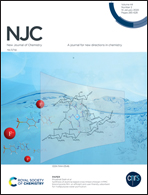Heteroleptic cationic iridium(iii) complexes bearing phenanthroline derivatives with extended π-conjugation as potential broadband reverse saturable absorbers†
Abstract
Three cationic heteroleptic iridium(III) complexes [Ir(piq)2(N^N)]+ (where piq refers to 1-phenylisoquinoline and N^N represents the fluorenyl-substituted phenanthroline (phen, 1), dipyrido-[3,2-a:2′,3′-c]phenazine (dppz, 2) and benzo[i]dipyrido[3,2-a:2′,3′-c]phenazine (dppn, 3)) were synthesized and their singlet and triplet excited-state characteristics were investigated via spectroscopic methods and theoretical calculations. The electronic absorption spectra of 1–3 in toluene all featured strongly absorbing ligand-center 1π,π* transitions below 380 nm, broad and intense diimine ligand-localized 1ILCT (intraligand charge transfer)/1π,π* transitions at 380–450 nm, weaker 1LLCT (ligand-to-ligand charge transfer)/1MLCT (metal-to-ligand charge transfer) transitions at 450–520 nm, and very weak spin-forbidden 3LLCT/3MLCT/3π,π* transitions at 550–680 nm. Variations of the core diimine ligand from phen to dppz caused a slight red-shift of the absorption bands at <450 nm for 2 compared to that of 1; while changing the core diimine ligand to dppn in 3 induced a more pronounced red-shift of the bands at 380–680 nm compared to those of 1 and 2. All three complexes exhibited structured room-temperature phosphorescence maximized at 590 nm and broad triplet excited-state absorption at 450–800 nm in toluene. However, the emission quantum yield of 3 was more than two orders of magnitude lower than those of 1 and 2 in toluene because the emitting state of 3 was the 2nd triplet excited state (T2). The nature of the lowest triplet excited state (T1) in toluene varied from the piq ligand localized 3π,π* mixed with some 3MLCT/3LMCT (ligand-to-metal charge transfer) characters in 1 and 2 to dppn ligand-based 3π,π*/3ILCT configuration in 3. The different nature of the T1 state in 3 resulted in a much stronger transient absorption (TA) at ca. 540 nm and 600–800 nm with a much longer TA lifetime (∼23 μs). In addition, the T1 state varied from pig ligand-localized 3π,π*/3MLCT/3LMCT in toluene to dppz localized 3π,π*/3ILCT state in CH3CN for 2, which resulted in a shorter triplet lifetime, reduced emission quantum yield, but stronger TA signals in the NIR regions for 2 in CH3CN. Because of the strong triplet excited-state absorption of 1–3 at 532 nm, all three complexes manifested strong reverse saturable absorption (RSA) at 532 nm, with the RSA trend following 3 > 2 > 1. Fluorenyl substitution not only enhanced the RSA at 532 nm for 2 and 3, but also made them potential broadband reverse saturable absorbers.



 Please wait while we load your content...
Please wait while we load your content...